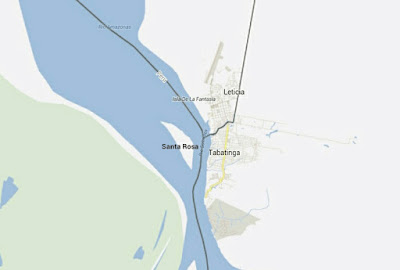May 8 - 11
After a 3.5 hour bus trip, I arrived at a small resort called El Rodadero where I'd booked a hostel for a night. While it was nice, the resort was actually 10 minutes drive from Santa Marta proper, which I hadn't realised. I caught up on a bit of relaxing and emails, got in touch with the volunteering foundation and agreed to meet Helga, their local coordinator, in town the next day, when I moved to a hostel in town, just a couple of blocks from the beach.
I spent the afternoon exploring the central town, which was much less touristy than Cartagena and with lots of locals out and about, with a cool little vibe in town. Santa Marta was actually where
Simón Bolívar died, one of the main leaders of the revolutionary movement in South America, and the first president of Colombia. Bolivia is, of course, named after him.
 |
Simón Bolívar
Nació en Caracas el 24 de Julio de 1783
Murió en Santa Marta el 17 de Diciembre 1830 |
One of the other volunteers, Emma, was staying at the same hostel, so I met her the next morning to catch the bus to the school.
Fundación Mariposas Amarillas (the "Yellow Butterflies Foundation" -
www.fmacolombia.weebly.com) runs two schools for children in poorer areas of Santa Marta, each with some 15 kids between about 4-10 years old. They also have a couple of other programmes, such as teaching English to adults. They'd got me to help out at their
Barrio Fundadores school, where we arrived after half an hour on a bumpy minivan labelled "
Directo Bastidas", right on the edge of town.
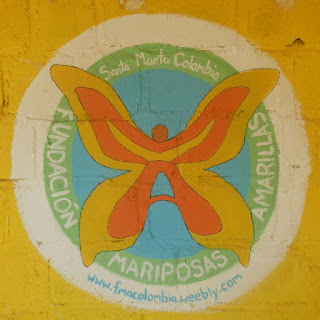 |
| Fundación Mariposas Amarillas logo on the side of the schoolhouse |
It was a pretty poor sort of area, and us two gringos definitely stood out, although I think the locals were pretty used to seeing the little school's "teachers" come past. I made sure to keep my watch and camera out of sight though. The school had a couple of small rooms with a no-glass window to let in the wind as a relief from the heat and humidity (you needed it). In another back room, Ampara and her son Ricardo lived together, supported by the foundation. While he didn't attend the school, Ricardo sometimes came along for sports and was a very talented artist. Ampara would make us a cup of coffee each morning and sometimes help out a little in the school.
 |
| Lining up to get a banana at breaktime outside the school |
The kids were just as gorgeous and photogenic as those I'd met in Cusco, and just as happy to see their teachers arrive. However for these kids, this school is the only place they learn any thing, as they didn't attend a state-run school. It meant the focus was much more on teaching, and just teaching the basics at that. However, my first day was a Thursday - sports day. So after enough of the kids arrived, we walked down to a small, sandy, dusty sports area. Sports was very popular, as at Cusco, and they enjoyed playing a few simple games such as bullrush (tag, not tackle!) and a "duck, duck, chicken" variant. They then headed back to the school a bit earlier than usual to make Mothers Day cards (how cute!).
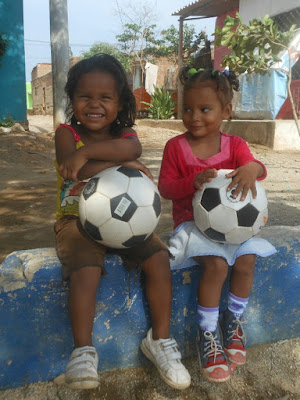 |
| Two of the gorgeous girls at sports day |
That night I went out for dinner with the two other volunteers, both of whom were ending their stints at the school the next day, Friday. It was also quite a casual day, as the mothers all came along, got a bit of cake and the cards the kids had made the day before, and Helga talked to them a bit about the school, reinforcing the importance of the kids arriving on time etc.
Then of course it was the weekend! I'd organised to move in to a homestay for the next week, which would give me a much more genuine local experience than the hostel. The other volunteer at the school, Nicole, was also staying there and asked if I'd like to go with her and a couple of friends she knew (2 of them Colombians) to Playa Blanca in Parque Nacional de Tayrona, which is quite famous for it's lovely beaches and landscape. Unfortunately, the government charge an extortionate 37,500 pesos (about NZ$23) for foreigners just to enter the park, and only 14,000 pesos for locals - but our friends' attempt to get us through for the locals price was thwarted by my blonde hair...
After another hour or so of driving on a very pot-hole ridden road, we arrived at another beach from where you had to take a boat or walk. We eventually decided to walk, and it ended up being only just over half an hour. Playa Blanca is quite popular with Samarios (people from Santa Marta) in the weekend, with companies providing a bus and boat service, so it was packed with people, but understandably so - it was a lovely spot. We enjoyed the small picnic lunch we'd brought, lounged in the sun, swam in the crystal clear water for which the beach is named, and chatted about the world in general - all in Spanish, which was a good test for me, and which I mostly understood!
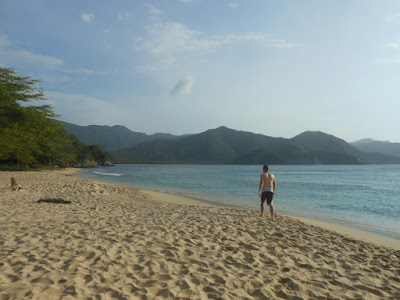 |
| Nice spot huh? Playa Cristal, Carribean coast of Colombia - after the crowds had left |
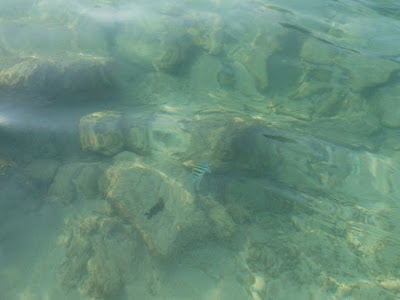 |
| The crystal-clear waters for which the beach is named made for some good snorkelling and views of a few brightly-decorated fish |
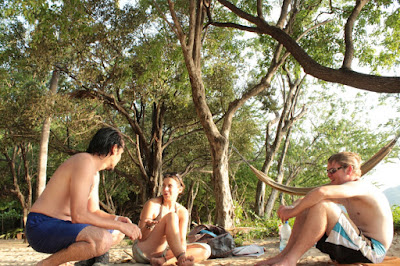 |
| Juan Carlos, Nicole and I debating the world in Spanish |
About 4.30pm, all the boats took everyone back to the end of the road - but because we'd come in on a private car, we were about to stay a while longer and enjoy the now-empty beach to ourselves. We walked back to the car around 5.30pm, catching a glorious sunset across the water as we walked...
 |
| Glorious much? |
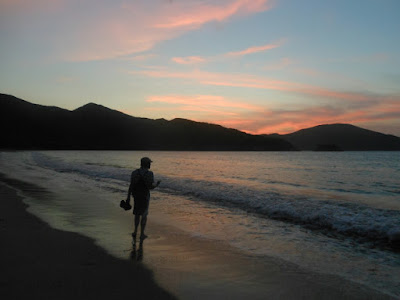 |
| Jealous yet? |
As we drove back, we spotted a number of dark spots on the road - and realised they were crabs, who I guess were crawling back to their night spots. It was unavoidable not to drive over some of them - and some were quite big, making a rather sickening crunch!
We got back to Santa Marta with a bit of a party mood, and so headed over to Taganga, 10 minutes north of Santa Marta over a little hill (as I tried to explain to the others that the kiwi is a flightless bird native to NZ, and not a fruit!). Taganga used to be a small fishing village that is now the gringo central of Santa Marta, with lots of hostels and beachfront bars and restaurants. We got various fish dishes (how could you get anything else?!) and a couple of beers, grabbed a cocktail and then headed to The Mirador - a rather awesome club up on the hill. It was open air, and had a lovely view down over the little town and bay - and lots of partying gringos and locals alike till well into the early hours...
I had a few other adventures in Santa Marta too - the rest of the long weekend, and a week volunteering at the school - but this post is getting a bit long, so it'll have to wait.
